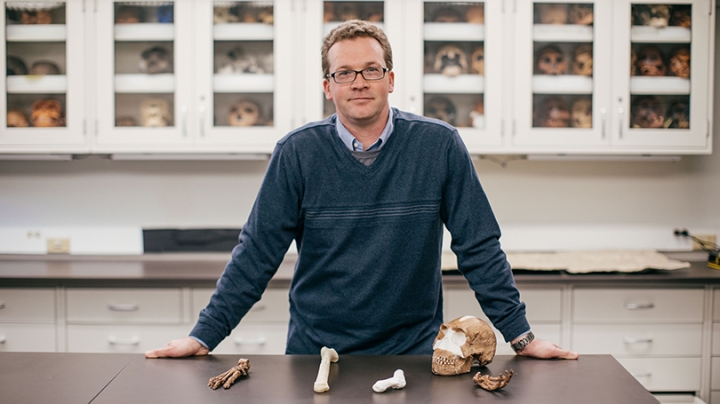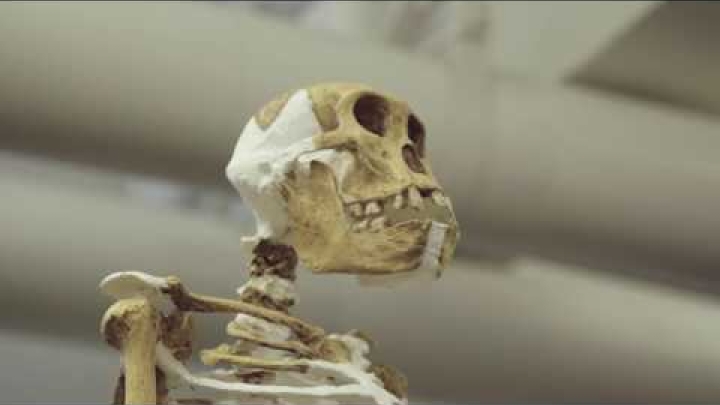“It’s not often that people stop and think about how weird it is that we walk on two legs,” says Jeremy DeSilva, an associate professor of anthropology who specializes in the evolution of human locomotion.
That simple question—why are humans bipedal, when almost all other mammals walk on four legs—has implications for everything from chronic back pain to the evolution of pro-social behaviors like compassion and empathy, DeSilva says.
It’s also the subject of Dartmouth’s latest massive open online course, or MOOC, “Bipedalism: The Science of Upright Walking.” The free five-week course, which begins Sept. 26, is the most recent addition to DartmouthX, a growing collection of MOOCs Dartmouth has been creating since 2014 in partnership with the nonprofit online learning consortium edX. Registration for “Bipedalism” is open now.
For DeSilva, who began his science career as an educator at the Boston Science Museum before earning his PhD in anthropology from the University of Michigan in 2008, the DartmouthX course is a way to reach a broader audience.
“How can I communicate what I’m learning about these fossils and the origins of upright walking to a much broader audience?” he says. “I love the idea that I can communicate to whoever else thinks this is interesting.”
A Team Effort
Like the other courses within the DartmouthX program, creating “Bipedalism” has been a team effort. DeSilva has partnered with instructional designer Adam Nemeroff, videographer Sawyer Broadley, anthropology and social sciences librarian Amy Witzel, and undergraduate and graduate students. Together they’ve produced short videos (including one of a visit to an emu farm and a black bear rehabilitation center, and one of DeSilva walking and running on a treadmill), created knowledge assessments, researched the baseball-card-like ID cards that will accompany each fossil the course discusses, and designed a variety of activities for students to participate in. In addition, DeSilva and the course team are partnering with the Smithsonian’s Human Origins Program to provide students with additional resources on human evolution.
The team has also been creating three-dimensional scans of key fossils, which students will be able to interact with on the edX platform. “It’s the closest thing on a screen to being able to touch the fossil and see for themselves the anatomies that I’m trying to describe,” DeSilva says.
DeSilva, who has participated in some major recent discoveries of our early hominin ancestors—notably, the 2015 discovery of Homo naledi—and has led Dartmouth students on research digs in South Africa, wants course participants to experience that sense of discovery. “In one of the activities, we have produced a mock fossil site where there are scans of bones that have been discovered, and you can click on the bones and rotate them and see their anatomy to tell whether any of these come from something walking on two legs, and learn how the shapes of these bones actually allow us to interpret what animals were at that site,” he says.
The course will include online discussions and virtual office hours during which DeSilva will be available to answer questions—although, he says, “I’ll probably ask questions right back, because a lot of the material that we talk about is so fluid. We’re making all these new discoveries, and what we thought we knew even a couple of years ago we’re now realizing is oversimplified. So whatever I’m teaching now is probably oversimplified from what we’ll know 10 years from now.”
Impact on the Classroom
DeSilva says the materials he and the team have developed for the online course are changing how he teaches in the classroom, from giving students access to the 3-D fossil scans to “flipping” the class—assigning students short videos to watch to prepare for class discussions.
“Instead of me in the classroom lecturing them on the different hypotheses for why we walk bipedally, they can watch a five-minute video before class and then in class we can have a debate about the selective advantage of bipedalism,” he says. “And then we can talk about what evidence you would need to collect to either refute or confirm their hypotheses—so really get into the nature of how science actually works and get past the basic information.”
This direct impact on the classroom experience is part of the overall goal of the DartmouthX program, and of MOOCs in general, says Josh Kim, director of digital learning initiatives.
“What MOOCs have done is open a window for our institutions to have a conversation about how learning is changing,” Kim recently wrote in an op-ed published on the website Inside Higher Education. The courses, he says, require faculty and staff to test new technologies and new methods of a teaching.
“Most importantly,” Kim writes, “MOOCs have caused those of us involved in the open online experiment to think deeply about what can be done only in traditional courses.”
DeSilva is no stranger to Dartmouth’s instructional design resources (he happens to be married to instructional designer Erin DeSilva), but he says the experience of developing this course has driven home for him the value of designing curricula around specific learning objectives.
“There’s been such intentionality to the development of this, and in a much broader sense it has allowed me to think about how I teach in general,” he says. “As I create a syllabus, what are my learning objectives, what do I want my students to walk out of the door thinking about, what skills do I want them to have developed, rather than what factoids do I want them to know?”
The experience, DeSilva says, has also inspired him to write a proposal for a book about bipedalism geared to a general audience. “I think we’ve had a big wake-up call in the last couple of years in the scientific community,” he says. “Science is being attacked in ways we haven’t ever seen before, and there is a general mistrust of science. We need to do more to communicate to the world what we do and why we do it and why it’s cool.”
About DartmouthX
To date, Kim says, more than 113,706 students have enrolled in DartmouthX courses, including more than 78,000 from outside the United States.
Past courses have included:
- “The American Renaissance: Classic Literature of the 19th Century”
- “Introduction to Environmental Science”
- “The Engineering of Structures Around Us”
- “Introduction to German Opera”
- “Introduction to Italian Opera”
- “Question Reality! Physics, Philosophy, and the Limits of Knowledge”
- “Retail Fundamentals”
- “Omnichannel Retail”
Several others are in development, including:
- “Free Will, Attention, Top-Down Causation, and Consciousness in the Brain”
- “John Milton’s Paradise Lost”
- “Materials in Gear”
- “Complementary and Alternative Medicine”
- “C Programming for the Beginner”

